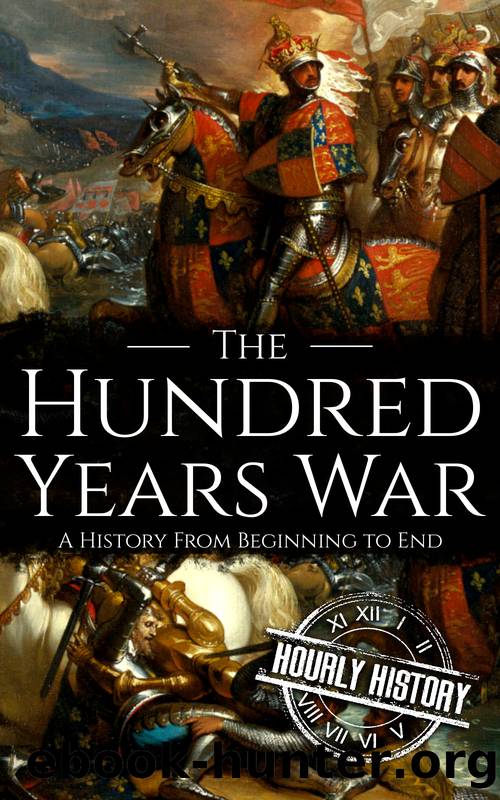The Hundred Years War: A History from Beginning to End by History Hourly

Author:History, Hourly [History, Hourly]
Language: eng
Format: epub
Published: 2019-10-05T16:00:00+00:00
Chapter Six
England Triumphant: 1415-1429
âWar without fire is like sausages without mustard.â
âJean Juvénal des Ursins, on Henry Vâs firing of Meaux in 1421.
The English army landed in northwestern France on August 13, 1415 and laid siege to the port city of Harfleur, beginning what became known as the Lancastrian War, the third and final portion of the Hundred Yearsâ War. The siege took longer than expected, and the city did not finally surrender until September 22. Henryâs landing in France prompted the warring Burgundians and Armagnacs to declare a truce and to agree to try to defeat the English king before continuing their civil war. With winter approaching, the English army finally began to march on October 8. Henryâs intention was to take his army through Normandy to the English-held city of Calais. This was intended as a deliberate provocation, and Henry hoped that this march would draw the French army into battle. He was right, but even he could not have foreseen the scale of the battle that would follow nor its consequences.
On the morning of October 25, 1415, the English and French armies faced one another on a narrow strip of recently plowed land between the forests of Tramecourt and Azincourt, not far from the Somme River. Things didnât look good for the English. They were hungry and weary after marching for more than two weeks, and they were not only massively outnumbered by their French enemies, but they also lacked mounted knights, the best shock-troops of the day.
Historians have disputed the precise numbers of troops involved, but it appears that the English king led a force of somewhere in the region of 1,500 men-at-arms supported by up to 7,000 longbowmen. Facing them was a French army of around 15,000 to 20,000 including large numbers of heavily armed and armored knights on foot and horseback. Even as the two armies faced each other, the French delayed launching an attack while more troops arrived to join their army.
To the French, victory seemed a foregone conclusion, and there was great competition between the French knights for the honor of leading the attack. Around three hours after sunrise, the French launched a massive attack on the English line by mounted knights. They expected that this would smash the English army, but instead it quickly turned into a French disaster. Heavy overnight rain had left the ground between the armies a sea of mud which critically slowed the French charge. The English had driven wooden stakes into the ground the evening before, and these provided an insupportable barrier to the approaching horsemen. Worst of all, the English longbowmen maintained âa terrifying hail of arrow shotâ on the approaching cavalry. The French attack slowed, then stopped, then turned into a headlong retreat with wounded and panicked horses plunging through the lines of infantry which were arrayed behind the cavalry.
Next, the French sent in the mass of men-at-arms, thousands of men on foot wearing plate armor. These unfortunates were forced to slog through muddy ground
Download
This site does not store any files on its server. We only index and link to content provided by other sites. Please contact the content providers to delete copyright contents if any and email us, we'll remove relevant links or contents immediately.
| Africa | Americas |
| Arctic & Antarctica | Asia |
| Australia & Oceania | Europe |
| Middle East | Russia |
| United States | World |
| Ancient Civilizations | Military |
| Historical Study & Educational Resources |
Magic and Divination in Early Islam by Emilie Savage-Smith;(1517)
Bohemians, Bootleggers, Flappers, and Swells: The Best of Early Vanity Fair by Bohemians Bootleggers Flappers & Swells- The Best of Early Vanity Fair (epub)(1370)
Ambition and Desire: The Dangerous Life of Josephine Bonaparte by Kate Williams(1366)
Papillon by Henry Charrière(1363)
Twelve Caesars by Mary Beard(1296)
Operation Vengeance: The Astonishing Aerial Ambush That Changed World War II by Dan Hampton(1149)
What Really Happened: The Death of Hitler by Robert J. Hutchinson(1146)
London in the Twentieth Century by Jerry White(1127)
Time of the Magicians by Wolfram Eilenberger(1112)
The Japanese by Christopher Harding(1109)
Twilight of the Gods by Ian W. Toll(1105)
Lenin: A Biography by Robert Service(1065)
The Devil You Know by Charles M. Blow(1007)
A Social History of the Media by Peter Burke & Peter Burke(961)
Freemasons for Dummies by Hodapp Christopher;(949)
Napolean Hill Collection by Napoleon Hill(920)
Henry III by David Carpenter;(908)
The Churchill Complex by Ian Buruma(894)
The Rise and Triumph of the Modern Self by Unknown(893)
